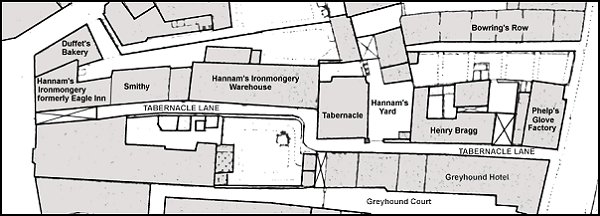tabernacle lane Smithy
tabernacle lane smithy
A blacksmith's smithy throughout Victorian times
In the 1841 census blacksmith Henry Bragg was listed as living in Tabernacle Lane with his wife Susan and their nine children. Henry Bragg was born in Yeovil in 1800 and his house and the Tabernacle Lane smithy are shown on the map below. He lived and worked here for over twenty years and his widow, Susan, lived on here until the 1870's.
In the 1851 census the lane was called Hannam’s Lane and by this time John Perry had taken over the blacksmith’s shop. He was living there with his wife Jemima and their five children, including son Philip who, at the age of 14 was listed as a blacksmith journeyman – inferring he had served a seven year apprenticeship!
Henry Bragg, now listed as a whitesmith, was still living in the lane with his family. A whitesmith was a tinsmith or tinplate worker, and often called a tinman in Victorian times. He would make and repair items made of light-coloured metals, particularly tin. By extension it could also refer to the person who deals in tinware. A whitesmith generally worked with tin, pewter, or other materials. Unlike blacksmiths who work mostly with hot metal, whitesmiths do the majority of their work on cold metal, although they might use a hearth to heat and help shape their raw materials. The term was also applied to metalworkers who did only finishing work such as filing or polishing. It would appear therefore that Henry had left the blacksmith's forge for the lighter work of a tinsmith.
The 1861 census called the lane 'Little Lane' and listed George Hull as the resident blacksmith. By this time Henry Bragg had died and his widow Susan was listed as a leather glove maker.
By the 1871 census the name had reverted to Tabernacle Lane and included the family of annuitant Susan Bragg and resident blacksmith John Higdon and his family.
The total number of families had reduced to two by the 1881 census and Susan Bragg who had lived in the lane since at least 1841 had died. The smithy had been taken over by 31-year old James Brown who employed one man and one boy there. He lived at the smithy with his wife Mary Ann and their children.
By 1891 29-year old Trent-born George Brown had taken over the blacksmith's forge from his brother James and was living there with his wife Beatrice and their three young children.
By the time of
the 1901 census,
although there
were still two
families living
in Tabernacle
Lane, the smithy
had gone.
MAP

This map is based on the 1886 Ordnance Survey above, but rotated 90° with the Borough at extreme left and South Street at extreme right. The smithy is located towards the northern end of Tabernacle Lane and Henry Bragg's house is at the southern end.